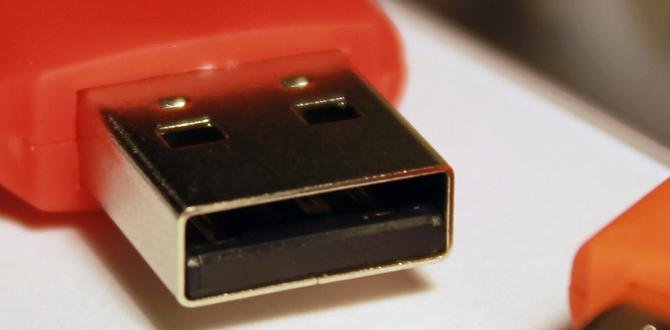TV Ports Explained: Bluetooth is your easy connection! This guide decodes TV ports, focusing on how Bluetooth helps you connect wireless headphones, speakers, and soundbars easily. We’ll break down what each port does and how to use Bluetooth to ditch the wires for a seamless home entertainment experience.
Hey there, tech adventurers! Bob E Riley here, ready to tackle another common puzzle in your home entertainment setup. Ever stare at the back of your TV, faced with a jumble of ports and wonder what they all do? And what’s this “Bluetooth” thing everyone talks about for sound? You’re not alone! It can feel like a secret code designed to confuse. But don’t worry, we’re going to unravel it all together. This guide is your friendly roadmap to understanding your TV’s connections, with a special spotlight on making full use of Bluetooth for fantastic wireless audio. Get ready to say goodbye to tangled wires and hello to simple, great sound!
What Are TV Ports, and Why Do They Matter?
Think of your TV ports as little doorways. They’re the connection points that allow your TV to talk to everything else in your entertainment system – from gaming consoles and Blu-ray players to soundbars and, yes, even your wireless headphones. Each port is designed for a specific type of signal, whether it’s video, audio, or data, and understanding them is key to getting the best experience possible from your devices. Having the right connections means you can hook up the latest gadgets or upgrade your sound system without a hitch.
The Most Common TV Ports You’ll Find
Let’s take a tour of the usual suspects you’ll see populating the back or side of your television. Knowing these will make connecting any device a breeze.
HDMI: The All-in-One Wonder
High-Definition Multimedia Interface (HDMI) is the undisputed king of TV connections today. It’s like the Swiss Army knife of ports, capable of carrying both high-definition video and clear digital audio signals over a single cable. This is why it’s the go-to for connecting everything from your streaming devices (like Apple TV or Roku) and gaming consoles (PlayStation, Xbox) to your soundbars and Blu-ray players. Most modern TVs have multiple HDMI ports, and some even have special ones like HDMI ARC or eARC.
HDMI ARC and eARC Explained
This is where things get really interesting, especially for sound! ARC stands for Audio Return Channel, and eARC is its enhanced version (Enhanced Audio Return Channel). What does that mean for you? Simply put, it allows your TV to send audio back to your soundbar or AV receiver using the same HDMI cable that’s sending video to your TV. This is incredibly useful because:
- You only need one HDMI cable between your TV and your soundbar/receiver.
- It supports higher-quality audio formats, especially with eARC, delivering a more immersive sound experience.
- It simplifies remote control – your TV remote can often control the volume of your connected audio device.
To use ARC or eARC, both your TV and your audio device (soundbar or receiver) need to have an HDMI port labeled “ARC” or “eARC.” You’ll typically use the HDMI port closest to the TV’s power cord, as this is often the designated ARC/eARC port.
USB Ports: For More Than Just Power
Universal Serial Bus (USB) ports are incredibly versatile. On your TV, you’ll primarily see USB ports used for a few things:
- Playing Media: You can plug in a USB flash drive or external hard drive filled with photos, videos, or music, and your TV can often play them directly.
- Firmware Updates: Sometimes, manufacturers provide software updates via USB.
- Powering Devices: You can power smaller devices like some streaming sticks or external USB-powered accessories.
- Connecting Peripherals (Less Common on TVs): While more common on computers, some TVs might allow connection of keyboards or game controllers via USB for specific smart TV apps or games.
Note that not all USB ports are created equal. Some might be faster or provide more power than others. For media playback, check your TV’s manual to see what file formats it supports.
Optical Audio Out: A Digital Sound Path
The Optical Audio Out port (sometimes called Digital Audio Out or S/PDIF) is another way to send digital audio from your TV to an external audio system like a soundbar or AV receiver. It uses a fiber optic cable that glows with light to transmit the sound signal. This is a great option if your TV doesn’t have HDMI ARC/eARC or if you want a separate audio connection.
Key advantages:
- Excellent digital audio quality, free from electrical interference.
- Compatible with surround sound formats like Dolby Digital.
Things to keep in mind:
- It only transmits audio, not video.
- It doesn’t support the newest, highest-bandwidth audio formats like Dolby Atmos passed through via HDMI eARC.
To connect, you’ll need an optical audio cable (often called a TOSLINK cable) between your TV’s optical out port and your soundbar/receiver’s optical in port.
Headphone Jack: For Private Listening
This one’s familiar! The standard 3.5mm headphone jack is for plugging in wired headphones or speakers directly into your TV. It’s perfect for when you want to listen without disturbing others. However, many modern TVs are ditching this port in favor of wireless solutions.
Ethernet Port: For a Stable Internet Connection
The Ethernet port looks like a slightly larger phone jack. It’s used to connect your TV directly to your home network router using an Ethernet cable. While many TVs now rely on Wi-Fi, a wired Ethernet connection often provides a more stable and faster internet connection, which is crucial for smooth streaming of 4K content or for online gaming. If you experience buffering or dropped connections with Wi-Fi, an Ethernet cable is a great solution.
Composite and Component Video Ports: The Older Connections
You might still find these on older TVs or some newer ones for backward compatibility. They are primarily for analog video signals.
- Composite Video: Uses a single yellow RCA connector for video, usually paired with red and white RCA connectors for stereo audio. The video quality is quite basic.
- Component Video: Uses three RCA connectors for video – typically red, green, and blue (Y, Pb, Pr). This offers better video quality than composite but is still analog and not as good as digital HDMI.
These are less common now, as digital connections offer vastly superior quality and simplicity.
Diving Into Bluetooth Connectivity
Now for the star of our wireless show: Bluetooth! Bluetooth is a short-range wireless technology that allows devices to communicate with each other without cables. It’s incredibly convenient for connecting audio devices to your TV.
Does Your TV Have Built-In Bluetooth?
This is the first and most important question! Many smart TVs released in the last few years come with built-in Bluetooth. How can you check?
- Look at the Manual: Your TV’s user manual is the definitive source.
- Check the Settings Menu: Navigate through your TV’s settings. Look for options like “Sound,” “Audio Output,” “Bluetooth,” or “Connections.” If you see a Bluetooth menu where you can search for devices, your TV has it!
- Look for the Bluetooth Logo: Sometimes, the TV itself or its remote might have a small Bluetooth symbol.
- Search Online: Look up your specific TV model number on the manufacturer’s website or a reputable review site.
If your TV doesn’t have built-in Bluetooth, don’t fret! There are still ways to add this functionality, which we’ll cover later.
What Can You Connect Via Bluetooth to Your TV?
The most common and satisfying use of Bluetooth on a TV is for audio devices:
- Wireless Headphones: Listen late at night or enjoy immersive gaming audio without cables.
- Wireless Earbuds: Similar to headphones, but often smaller and more convenient.
- Bluetooth Soundbars/Speakers: Enjoy enhanced audio without running speaker wires from your TV.
- Bluetooth Game Controllers: Some game controllers connect via Bluetooth, though many consoles use their own wireless dongles.
Pairing Your Bluetooth Device to Your TV: A Step-by-Step Guide
The process is generally straightforward, but menus can differ slightly between TV brands. Here’s a typical flow:
-
Put your Bluetooth device in pairing mode.
This varies by device. Often, you’ll need to press and hold a Bluetooth button until a light blinks, or the device will automatically enter pairing mode when it’s first turned on after being reset. Check your device’s manual for specific instructions. For headphones, it might be called “pairing mode” or “discoverable mode.”
-
On your TV, navigate to the Bluetooth settings.
This is usually found under Sound, Audio, Connections, or General settings. Look for an option like “Add Device,” “Search for Devices,” or “Pair Device.”
-
Initiate the TV’s scan for devices.
Your TV will start searching for nearby Bluetooth devices that are in pairing mode. This might take a few moments.
-
Select your device from the list.
Once your device appears on the TV screen (it should show its name, like “Sony WH-1000XM5” or “JBL Flip 5”), select it using your TV remote.
-
Confirm the pairing (if prompted).
Your TV might ask you to confirm a code or simply to “Pair” or “Connect.” Once successful, your TV will usually display a message confirming the connection.
-
Adjust audio output settings (if necessary).
Sometimes, even after pairing, you might need to go back into the sound or audio output settings on your TV and select your newly connected Bluetooth device as the audio output source.
Troubleshooting Common Bluetooth Connection Issues
Occasionally, things don’t go as smoothly as planned. Here are some common problems and how to fix them:
- Device Not Found: Ensure your Bluetooth device is fully charged, powered on, and definitely in pairing mode. Move it closer to the TV. Turn Bluetooth off and on again on your TV.
- Pairing Fails: Try unpairing the device from any other previously connected devices (like your phone). Reset your Bluetooth device to factory defaults if possible and try pairing again. Restart both your TV and the Bluetooth device.
- Intermittent Connection/Audio Drops: Bluetooth is susceptible to interference. Try moving the device closer to the TV. Ensure there are no thick walls or large metal objects between them. Turn off other nearby Bluetooth devices. Some older TVs might struggle with bandwidth for high-quality audio and video simultaneously.
- No Sound After Connecting: Double-check your TV’s audio output settings to ensure the Bluetooth device is selected as the active output. Also, check the volume on both the TV and the Bluetooth device.
- Latency/Audio Lag: This is a common issue with Bluetooth, where the audio is slightly out of sync with the video. It’s more noticeable with dialogue. Some TVs and Bluetooth devices (especially newer ones with the aptX Low Latency codec) can minimize this. If your TV has an audio delay setting, you can try adjusting it. For essential gaming or watching fast-paced action, a wired connection is often best if latency is a major concern.
What If My TV Doesn’t Have Bluetooth?
Don’t have a happy Bluetooth icon on your TV? No problem! You can easily add Bluetooth capabilities with a small, affordable adapter.
Bluetooth Transmitters and Receivers
These small devices plug into your TV and add Bluetooth functionality. There are two main types:
- Bluetooth Transmitter: This is what you’ll need for your TV. It takes an audio signal from your TV (usually via the headphone jack or optical audio out) and transmits it wirelessly to your Bluetooth headphones or speaker.
- Bluetooth Receiver: This does the opposite – it receives a Bluetooth signal (e.g., from your phone) and plays it through a non-Bluetooth speaker system.
Some devices are actually transmitters and receivers in one, offering flexibility. When choosing a transmitter for your TV, consider:
- Audio Input Options: Ensure it has ports that match your TV’s output (e.g., 3.5mm headphone jack, RCA, or optical).
- Bluetooth Version: Newer versions (like Bluetooth 5.0 or 5.1) offer better range, stability, and lower latency.
- Low Latency Support: If you care about audio sync, look for transmitters that support codecs like aptX Low Latency (aptX LL). Note that both the transmitter and your headphones/speaker must support aptX LL for it to work.
How to use a Bluetooth transmitter:
- Plug the transmitter into your TV’s audio output port (e.g., headphone jack or optical out) and its power source (usually USB).
- Pair your Bluetooth headphones or speaker with the transmitter according to the transmitter’s instructions.
- Set your TV’s audio output to the port you connected the transmitter to (e.g., “Headphones” or “Optical Out”).
Reputable sources like the TechRadar provide detailed reviews of these devices to help you make an informed choice.
Understanding Audio Codecs and Their Importance
When we talk about Bluetooth audio, it’s worth a quick mention of codecs. Codecs are algorithms that compress and decompress audio data for transmission. Different codecs impact sound quality and latency.
Here’s a quick rundown of common codecs you might encounter:
| Codec | Pros | Cons | Best For |
|---|---|---|---|
| SBC (Subband Coding) | Universal compatibility, basic functionality. | Lower audio quality, higher latency. | General listening, when compatibility is key. |
| AAC (Advanced Audio Coding) | Better quality than SBC, widely used by Apple devices. | Can have slightly higher latency than aptX. | Listening to music on Apple products, streaming. |
| aptX | Good audio quality, lower latency than SBC and AAC. | Requires support on both devices. | General audio listening with better quality. |
| aptX HD | Higher resolution audio quality, supports 24-bit music. | Requires more bandwidth, more battery consumption. | Audiophiles wanting higher fidelity wireless sound. |
| aptX Low Latency (aptX LL) | Significantly reduced latency (under 40ms). | Requires support on both devices, not always found on older devices. | Watching videos, gaming, where audio sync is critical. |
When selecting Bluetooth headphones or a transmitter, especially for TV use, look for support for aptX Low Latency if audio sync is a priority. Make sure both your TV (or transmitter) and your headphones/speaker support the same






